Adventures in Mathematical Knitting
By Sarah-Marie Belcastro
Rendering mathematical surfaces and objects in tactile form requires both time and creativity.
Rendering mathematical surfaces and objects in tactile form requires both time and creativity.

DOI: 10.1511/2013.101.124
I have known how to knit since elementary school, but I can’t quite remember when I first started knitting mathematical objects. At the latest, it was during my first year of graduate school. I knitted a lot that year, because I never got enough sleep and needed to keep myself awake during class.
During the fall term I made a sweater for my dad, finishing the seams right after my last final, and in the spring I completed a sweater for my mom. Also that spring, during topology class, I knitted a Klein bottle, a mathematical surface that is infinitely thin but formed in such a way that its inside is contiguous with its outside (see Figure 1). I finished the object during a lecture. It was imperfect, but I was excited, and at the end of class I threw it to the professor so he could have a look.
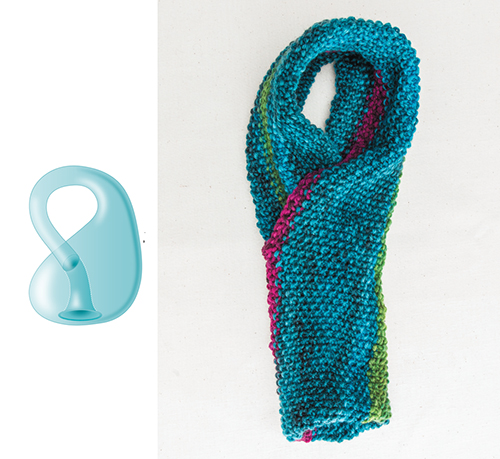
Illustration by Barbara Aulicino. Photograph by Austin Green
Over the years I’ve knitted many Klein bottles, as well as other mathematical objects, and have continually improved my designs. When I began knitting mathematical objects, I was not aware of any earlier such work. But people have been expressing mathematics through knitting for a long time. The oldest known knitted mathematical surfaces were created by Scottish chemistry professor Alexander Crum Brown. (For more about Crum Brown's work, click the image at right). In 1971, Miles Reid of the University of Warwick published a paper on knitting surfaces. In the mid-1990s, a technique for knitting Möbius bands from Reid’s paper was reproduced and spread via the then-new Internet. (Nonmathematician knitters also created patterns for Möbius bands; one, designed to be worn as a scarf, was created by Elizabeth Zimmerman in 1989.) Reid’s pattern made its way to me somehow, and it became the inspiration for a new design for the Klein bottle. Math knitting has caught on a bit more since then, and many new patterns are available. Some of these are included in two volumes I coedited with Carolyn Yackel: Making Mathematics with Needlework (2007) and Crafting by Concepts (2011).
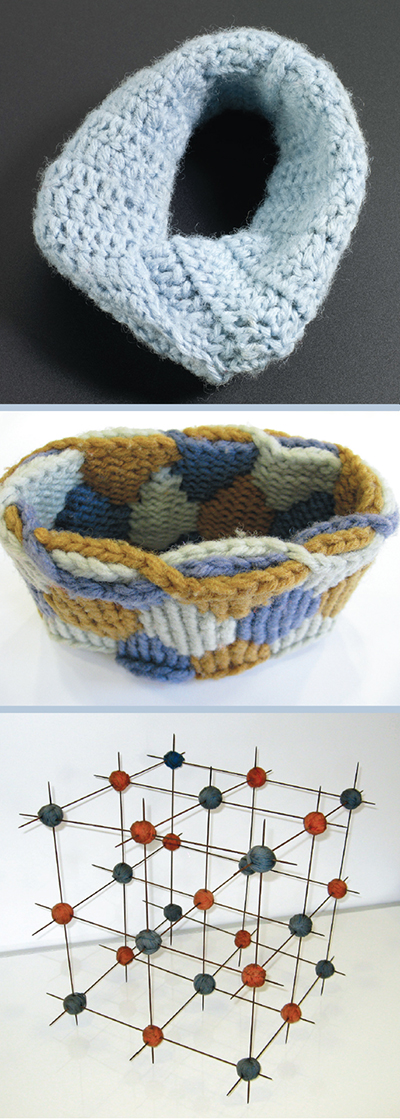
Photograph at top: Science & Society Picture Library. All other photographs courtesy of Andrew Alexander, University of Edinburgh School of Chemistry. Our thanks to Alexander and to Louise Hogg, also of the School of Chemistry, for notes on Crum Brown’s needlework.
You might wonder why one would want to knit mathematical objects. One reason is that the finished objects make good teaching aids; a knitted object is flexible and can be physically manipulated, unlike beautiful and mathematically perfect computer graphics. And the process itself offers insights: In creating an object anew, not following someone else’s pattern, there is deep understanding to be gained. To craft a physical instantiation of an abstraction, one must understand the abstraction’s structure well enough to decide which properties to highlight. Such decisions are a crucial part of the design process, but for the specifics to make sense, we must first consider knitting geometrically.
In a discrete geometric model for knitted fabric, plain knit stitches form a rectangular grid, or mesh, with one stitch sitting inside each rectangle (see Figure 2). We shape knitted fabric primarily by using increases and decreases. True to their names, increases add to the number of stitches in a row, and decreases lessen the number of stitches in a row. Both processes create mathematical curvature in the knitted fabric. Figure 3 shows an increase (angles and stitch sizes are not to scale). Interestingly, making a decrease has the same effect on the mesh; a decrease looks like an increase if the fabric is held upside down.
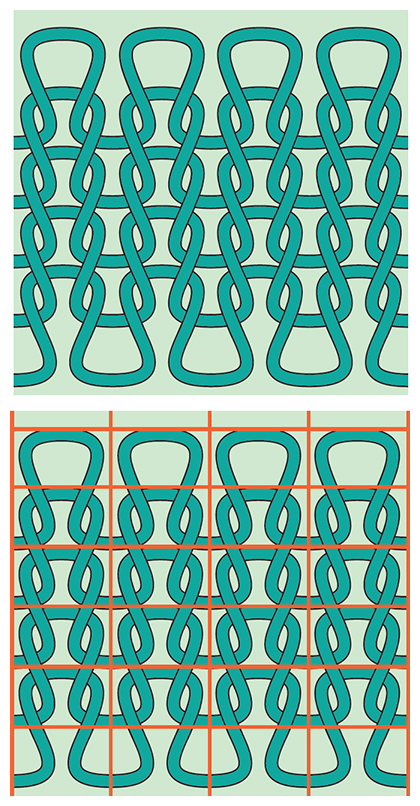
Barbara Aulicino
Rows and columns of stitches draw the eye along paths around the surface. Think of a sphere knitted from pole to pole: The rows and columns of stitches mimic latitude and longitude lines.
All knitting is the generation of global structure via choices made in local stitch creation. A set of stitches appears to create a coordinate system (a grid in two-dimensional space). Because shaped fabric is not mathematically flat, however, any such system is only consistent locally, for that small patch of stitches.
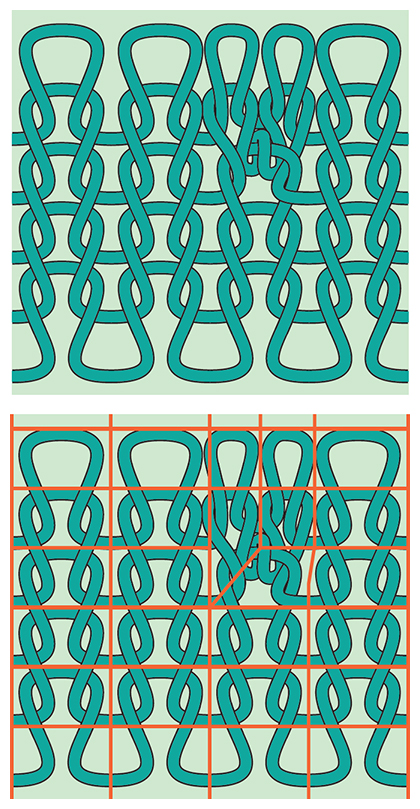
Barbara Aulicino
An object that has consistent coordinates locally, but perhaps not globally, is in mathematical terms a manifold. Manifolds have a dimensional restriction: Every patch on a manifold must have the same number of coordinate dimensions. A pullover sweater represents a manifold—unless it has sewn-on pockets, because where a pocket joins the sweater, there are three different coordinate directions (up-down, left-right onto the pocket and left-right under the pocket). A great deal of mathematical research concerns manifolds.
Most (but not all) knitted mathematical objects represent manifolds. In particular, although knitted fabric is of course three-dimensional, it represents two-dimensional things in the same way that paper represents an ideal 2D sheet. That means knitting can stand in for 2D objects—or for the boundaries (“skins”) of 3D objects. Some mathematical objects are 2D but cannot be represented in three dimensions without either intersecting themselves or having holes added. (These are objects that can be immersed, but not embedded, in real 3-space.) Klein bottles are in this class of objects.
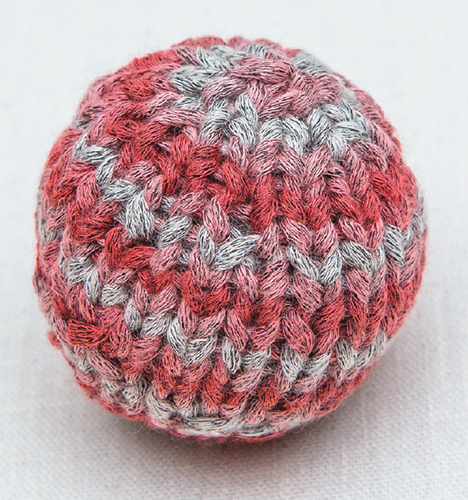
Austin Green
As mentioned earlier, a Klein bottle is an abstract, infinitely thin mathematical surface, formed in such a way that its inside is contiguous with its outside. That is, if it were thickened enough have an inner skin separate from its outer skin, you could run a finger along the surface from any point on the outside to the corresponding point on the inside. Figure 5 shows a line drawing of a Klein bottle in three dimensions, along with a true 2D representation as a marked rectangle; we bend and stretch the rectangle through additional dimensions to match up the arrows and glue them together. As the 3D representation shows, the surface appears to pass through itself. At this place there must be a self-intersection or a hole.
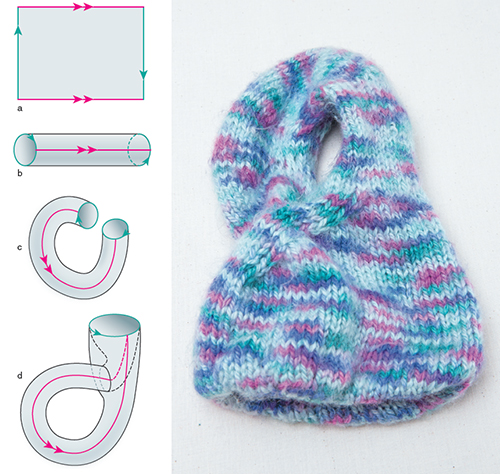
Illustration by Barbara Aulicino. Photograph by Austin Green
In the terms of the 2D representation, my first Klein bottle was made with the knitting needles parallel to the single arrows in the rectangle, and the rounds of knitting formed in the direction of the double arrows (see Figure 5). It had a lot of flaws, but at the time, I only noticed one of them: It was immobile, stuck in one configuration in 3-space, because I had made it with a self-intersection. To address this problem, I promptly made a crappy Klein bottle with a hole (see Figure 6).
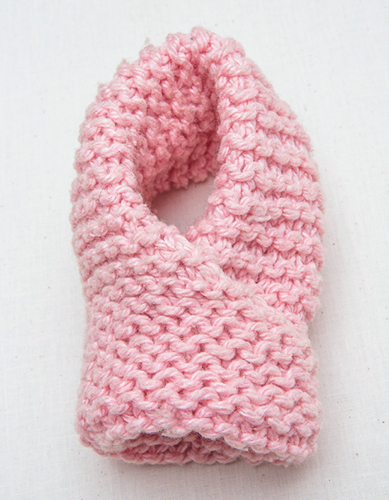
Austin Green
The shortcomings of my early Klein bottles fell into two categories: aesthetic and mathematical. Aesthetics first: These things were ugly! One reason is that I used terrible materials. I have always preferred to use circular knitting needles, which are composed of two pointed tips connected by a thin, flexible cable. Back in graduate school, I often used hacked-together needles, shortening the cables of needles from the 1960s by melting the plastic (which promptly fell apart) or constructing my own circular needles from wire and packing tape (which caught on the yarn incessantly). These efforts to make needles that were both short enough and flexible enough for the projects resulted in a frustrating knitting experience and less than lovely results. Later I was able to get bamboo needles with hollow cables, which can be successfully modified. And I have learned how to use standard knitting paraphernalia to achieve the results I desire.
It wasn’t just the needles, though—the yarn was a problem, too. That first Klein bottle was made from respectable but low-grade acrylic yarn. The second was made from a yarn of unknown provenance, which I found at a garage sale. It was awful to work with and had a sickening plastic-plus-fiberglass feel. These days, I tend to use high-quality rather than random yarns, and I choose the color, type of dyeing and texture of the yarn with the intended mathematics in mind. Finally, in designing the objects, I improvised without much thought for details, so the first Klein bottle is misshapen and the second has a weird vertical line on it (hidden in the figure).
Now for the mathematical issues. The approach I used in both cases was to knit something like a cylinder, pass one end of the cylinder through its side, and then graft the two ends of the cylinder together. One can build in a side slit (as I did with the second Klein bottle), or create a self-intersection by passing live stitches through the side of the cylinder (as I did with the first Klein bottle). Either way, using this method, one basically creates the Klein bottle from an identified rectangle, with the rows parallel to one pair of sides of the rectangle (single arrows in Figure 5) and the columns of stitches parallel to the other pair of sides of the rectangle (double arrows in Figure 5). It is very easy to graft the ends of the cylinder incorrectly. Unless the knitter introduces a half-twist before grafting, the four corners of the rectangle will not meet. Without the twist, the result is still a Klein bottle, but the coordinates suggested by the rows and columns of stitches do not match the coordinates of the underlying rectangle, and the geometry of the finished object is not as desired. A knitted cylinder, however, resists twisting—thus the difficulty in this step.
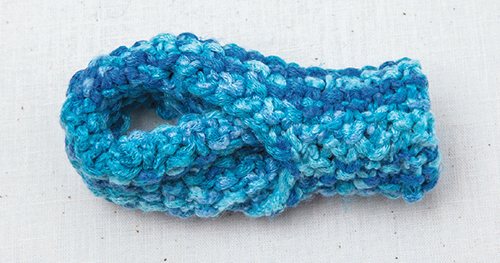
Austin Green
I eventually saw a solution to this problem: Create the twist intrinsically rather than adding it at the end. I accomplished this by starting with Miles Reid’s Möbius band construction. This method effectively places the needles parallel to the double arrows shown in Figure 5, and knitting proceeds up both of the single arrows at once, each row wrapping twice across the rectangle. Because the twist is already present in the knitted fabric, the desired joining of the underlying rectangle happens automatically, with coordinates that match the rows and columns of stitches. Skeletal instructions for knitting a Klein bottle in this fashion are available at my mathematical knitting website, and a photograph of one is shown in Figure 7.
That solution was the product of years of thought. Once I realized how flawed my first Klein bottles were, I wanted to do better, to create a design that was more faithful to the mathematics. Thus the question arose: What does it mean for a knitted object to be mathematically faithful?
The way an object is constructed, in any art or craft, highlights some of the object’s properties and obscures others. Modeling mathematical objects is no different: It requires that we make choices as to which mathematical aspects of the object are most important. When it’s possible to do so, I knit objects so that a particular set of properties is intrinsic to the construction.
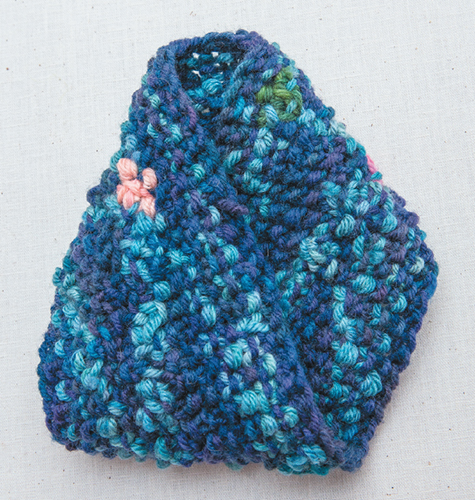
Austin Green
Most of the objects I make have both topological and geometric aspects. That is, these objects have an overall shape that is preserved when the objects are bent or stretched, and they have a specific form and structure in space. Sometimes the topology takes precedence and sometimes the geometry; this difference dictates whether and where curvature is placed on the object. Often I knit surfaces. These are 2D and mainly smooth, which means that the constructions should have no seams, visible or otherwise. An ideal model of a surface should have no edges or bound stitches. In reality, yarn must have two ends. Similarly, a knitted piece may be made from more than one piece of yarn, but the transition from one ball to another should be invisible. These characteristics are part of a topological model for knitting, which I described in a 2009 paper in the Journal of Mathematics and the Arts.
Another consideration in constructing knitted mathematical objects is surface texture. For example, an abstract Klein bottle’s inside adjoins its outside, so the texture of a knitted Klein bottle should be the same on the two physical sides; there should be no way of telling which real side is being looked at, and no way of identifying a transition between different parts of the knitted piece. For some other objects, the two sides are mathematically distinct and so their textures should be distinguishable.
There’s more to consider—one can also indicate mathematics using a design knitted into the object. As a simple example, one can use stripes to indicate Möbius bands within a Klein bottle.
Most knitted-in designs are mathematically challenging because of the discretization problem: A smooth line or patch of color drawn on a piece of paper or electronically must be knitted as a sequence of discrete stitches. This harkens back to the mesh shown in Figures 3 and 4. Computer scientists who work on visualization of 3D objects have developed algorithms for imposing a mesh on an idealized object. A finer mesh gives a smoother look, and in fact the use of very fine meshes is what produces realistic computer-generated imagery. In knitting, creating a finer mesh requires both a thinner yarn and substantially more time to complete the project. A great application of meshes to knitting appears in a 2012 SIGGRAPH paper, in which Cem Yuksel, Jonathan M. Kaldor, Doug L. James and Steve Marschner explain how they use a mostly rectangular mesh to produce highly realistic virtual knitted garments.
Discretizing a pattern is not as simple as imposing a mesh. Knitted stitches are not square in proportion; they are close to 5:6 in aspect ratio. This fact has to be taken into consideration during design; if it is not, the finished object will be elongated. I usually make a swatch of fabric in the yarn I’m planning to use, measure to see what the stitch aspect ratio will be and then create graph paper with appropriately proportioned rectangles. Next one must determine the overall shape—where there will be increases and decreases, short rows and other construction elements—and restrict the graph paper appropriately. The challenge comes in accurately placing designs or colors on that shape. Here are some examples.
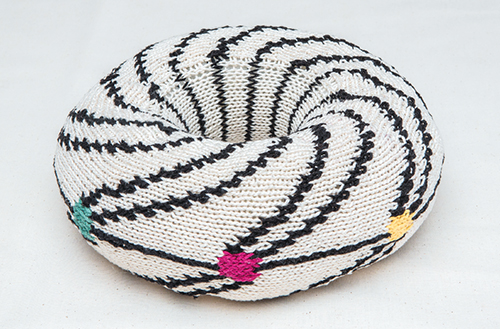
Austin Green
First, consider the torus. A torus is a surface that is essentially a hollow doughnut shape—it is formed by rotating a circle in 3D space about an axis. A torus knot is a closed path that can be drawn without crossings on the torus, so that when the rest of the surface is removed, the path is knotted. On a “flat” torus (similar to the “flat” Klein bottle drawn as a rectangle in Figure 5), a torus knot can be drawn as a straight path with a constant slope. Converting this to knitting requires changing the slope of the path with the curvature of the torus in a consistent way. Luckily, there is a knitted torus construction that minimizes the changes needed. Knitted torus knots are shown in Figure 10.
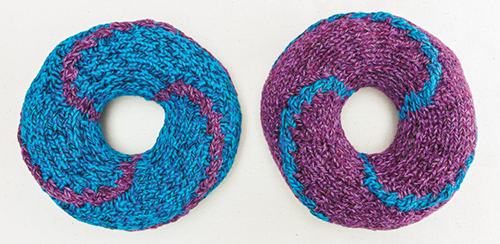
Austin Green
A further challenge is knitting a line or curve into an object with a bumpy surface texture. Each stitch has to be knit in a single color of yarn (because one stitch is the minimal mesh size), and the surface texture dictates that adjacent stitches interlock colors. Thus, to show a clear line, the line or curve has to be at least two stitches wide. Compare the graph drawn on both Möbius bands in Figures 8 and 11; one has a finer mesh than the other.
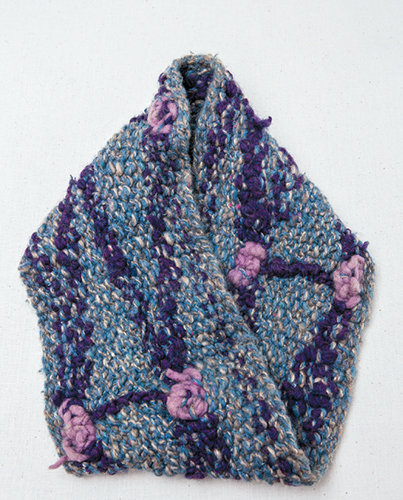
Austin Green
Knitting multiple line segments into a curved surface is also quite difficult. In another project, I knitted the complete graph K7 into a torus, pictured in Figure 9. This project required the use of 7-fold symmetry. To make it possible to distinguish between the line segments emanating from a dot, each had to have different slopes, and those slopes had to be modified with the construction of the torus. Additionally, the dots were of nonzero height and width, which threw off slope calculations further.
So, what exactly does the design process for a mathematical object entail? Here is how I proceed. After deciding on an object to model, I articulate my mathematical goals (in practice, I often do this unconsciously). The chosen goals impose knitting constraints. This gives me a frame in which to create the overall knitting construction for the large-scale structure of the object. Then I must consider the object’s fine structure. Are there particular aspects of the mathematics that I can emphasize with color or surface design? Are particular textures needed? While solving the resulting discretization problem, I usually produce a pattern I can follow—my memory is terrible and I would otherwise lose the work.

Austin Green
A recent mathematical creation can serve as a case study. A diagram in Allen Hatcher’s Algebraic Topology had caught my eye, and I thought it would look fantastic knitted. The object shown is an equilateral Y extruded to be a three-finned thing with one end rotated by 1/3 and glued to the other end. Although, unlike a Möbius band, the object is not a manifold, it is a generalization of a Möbius band. So I thought I could use a similar construction—if only I could devise a way to knit outward from the central circle (the center of the Y). I wanted the knitted object to be created from a single strand of yarn, because the mathematical object has a single edge. Thus, I had to create a way to use a single strand of yarn to produce three interlocking sets of free stitches. (Ordinary knitting has only two sets of stitches, upper and lower, per strand of yarn.) Once I had solved that problem—and it took me a while—I decided to use a texture that would look the same from all viewpoints, so that the central circle would be less visible. For my first attempt at the object, I decided to keep things simple and add no more requirements. The result is shown in Figure 12. After my first attempt was done, I took one look at it and realized that it resembled a cowl. I resized the next version to produce a garment. A wearable mathematical object is a rare, and welcome, practical result.
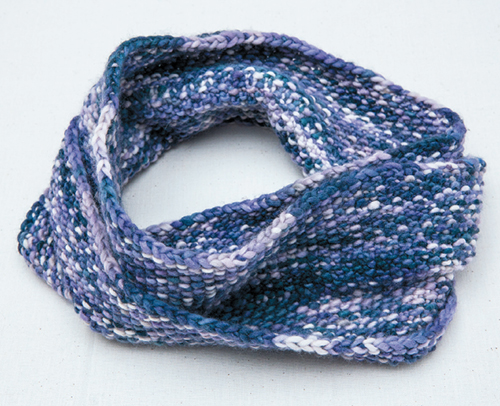
Austin Green
Although I have worked on various knitting projects, I’m still not finished fiddling with designs for the Klein bottle—and it’s been about 20 years since I began. I have been asked to adapt my construction into a wearable hat. It’s one among many mathematical knitting challenges I look forward to completing.
Click "American Scientist" to access home page
American Scientist Comments and Discussion
To discuss our articles or comment on them, please share them and tag American Scientist on social media platforms. Here are links to our profiles on Twitter, Facebook, and LinkedIn.
If we re-share your post, we will moderate comments/discussion following our comments policy.